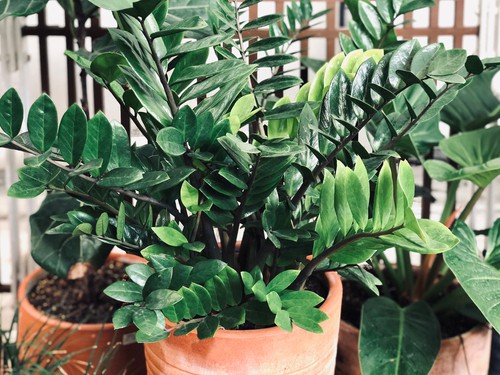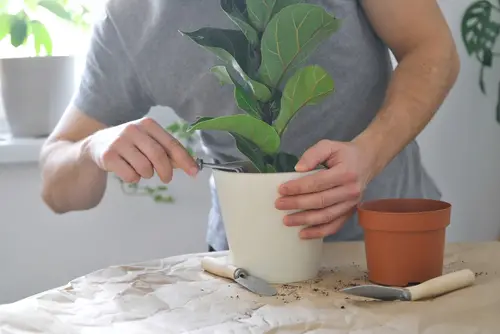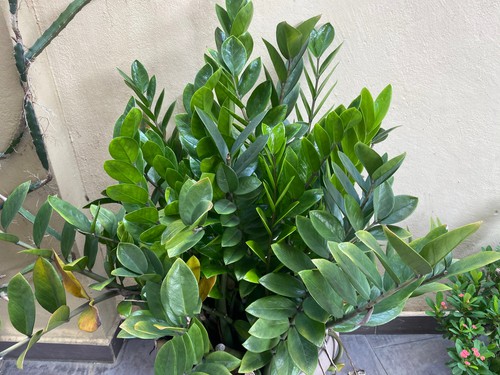ZZ plants are a great addition to any indoor space, but they can be susceptible to black spots. These unsightly marks can be a sign of a variety of issues, from overwatering to pest infestations. Fortunately, there are steps you can take to prevent and treat black spots on ZZ plants.
Understanding ZZ plants is the first step to identifying and addressing black spots. These low-maintenance plants are native to Africa and thrive in low-light conditions.
ZZ plants are known for their glossy green leaves and unique shape, which makes them a popular choice for indoor gardening. However, ZZ plants can be sensitive to overwatering and direct sunlight, which can lead to black spots on the stems and leaves.
Identifying why your ZZ plant have black spots is crucial to preventing further damage to it. Common causes of black spots include fungal diseases, insect infestations, overwatering, and sunburn. These issues can weaken the plant and lead to root rot, which can be fatal.
By understanding the causes of black spots, you can take steps to prevent and treat them, ensuring that your ZZ plant stays healthy and vibrant for years to come.
Key Takeaways
- Understanding ZZ plants is crucial to identifying and addressing black spots.
- Common causes of black spots include fungal diseases, insect infestations, overwatering, and sunburn.
- By taking steps to prevent and treat black spots, you can keep your ZZ plant healthy and thriving.
More on this category:
- Why Does My Snake Plant Have Holes?
- Why Does My Snake Plant Have Brown Tips?
- Why Does My Rubber Plant Have Brown Spots?
Understanding ZZ Plant

ZZ plants, also known as Zamioculcas zamiifolia, are native to Africa and have become popular indoor plants due to their ease of care and attractive glossy green leaves. These plants are known for their ability to thrive in low-light conditions and can go without water for long periods, making them ideal for busy plant owners.
ZZ plants are succulent plants, meaning they store water in their leaves, stems, and roots. This adaptation allows them to survive in arid environments, but it also makes them susceptible to overwatering. Overwatering can lead to root rot, a condition that can cause black spots on the leaves and stems of ZZ plants.
In addition to overwatering, ZZ plants can develop black spots due to fungal or bacterial diseases and insect infestations. Exposure to direct sunlight can also cause this issue. Black spots due to root rot or overwatering can be fatal for your plant, so it is important to find the exact causes before taking any treatment actions.
Identifying Black Spots
If you notice black spots on your ZZ plant, it is important to diagnose the issue quickly to prevent it from spreading and potentially killing your plant. Here are some tips on how to identify black spots on your ZZ plant:
- Inspect the leaves: Black spots on the leaves are usually the first sign of a problem. Look for irregularly shaped spots that may be raised or sunken. These spots may start out small and grow larger over time.
- Check the stems: In some cases, black spots may also appear on the stems of your ZZ plant. These spots may be dark or black in color and may also be raised or sunken.
- Look for other signs of damage: Black spots on your ZZ plant may be a sign of other issues, such as insect infestations, fungal diseases, or root rot. Look for other signs of damage, such as yellowing leaves, wilting, or a foul odor.
Once you have identified black spots on your ZZ plant, it is important to take action quickly to prevent the issue from spreading. Consider the possible causes of the black spots and take steps to address them. For example:
- Reduce exposure to direct sunlight: ZZ plants are sensitive to too much sunlight, which can cause stress and lead to black spots. Consider moving your plant to a shadier location.
- Adjust watering habits: Overwatering can also cause black spots on ZZ plants. Make sure your plant is not sitting in standing water and adjust your watering schedule as needed.
- Treat for pests and diseases: If you suspect that black spots on your ZZ plant are caused by pests or diseases, consider treating your plant with an appropriate insecticide or fungicide.
By identifying black spots on your ZZ plant early and taking action to address them, you can help ensure the health and longevity of your plant.
Why Does My ZZ Plant Have Black Spots – 4 Common Problems

ZZ plants are hardy and easy to care for, but they can still develop black spots on their leaves or stems. These spots can be alarming to see, but they are usually caused by one of several common issues.
1. Overwatering and Underwatering
One of the most common causes of black spots on ZZ plants is overwatering or underwatering. When the plant is overwatered, the roots can become waterlogged and begin to rot. This can lead to black spots on the stems and leaves, as well as yellowing and wilting.
On the other hand, underwatering can cause the plant to become dehydrated, leading to brown or black spots on the leaves.
To prevent overwatering or underwatering, ZZ plants should be watered only when the soil is dry to the touch. The soil should be allowed to dry out between waterings, and excess water should be drained away.
2. Exposure to Direct Sunlight
ZZ plants are native to tropical regions and are adapted to low light conditions. When they are exposed to direct sunlight or bright light for too long, they can develop black spots on their leaves or stems. This is because the intense light can scorch the plant, leading to sunburn and black spots.
To prevent this issue, ZZ plants should be placed in bright, indirect light. They should be protected from direct sunlight, which can be filtered through a sheer curtain or placed in a shaded area.
3. Pest Infestation
Pests such as aphids, scale, mealybugs, and spider mites can infest ZZ plants and cause black spots on the leaves. These pests feed on the plant’s sap, which can lead to discoloration and black spots.
To prevent pest infestations, ZZ plants should be inspected regularly for signs of pests. If pests are found, they can be removed manually or treated with insecticidal soap.
4. Fungal and Bacterial Diseases
Fungal and bacterial diseases can also cause black spots on ZZ plants. Sooty mold and black fungus are two common fungal diseases that can cause black spots on the leaves and stems. Bacterial infections can also cause black spots and discoloration.
To prevent fungal and bacterial diseases, ZZ plants should be kept in a well-ventilated area with good air circulation. They should also be watered properly to prevent waterlogging, which can lead to fungal growth.
If a fungal or bacterial infection is suspected, the affected parts of the plant should be removed and disposed of immediately.
Effects of Black Spots on ZZ Plants
Black spots on ZZ plants can be a sign of various problems that can affect the plant’s health and growth. In this section, we’ll discuss the effects of black spots on ZZ plants, focusing on the damage they can cause to the leaves, stems, and roots.
1. Damage to Leaves

One of the most common effects of black spots on ZZ plants is damage to the leaves. Black spots can cause the leaves to turn yellow, brown, or even black, depending on the severity of the problem. In addition, the leaves may become dry, brittle, and start to curl or droop.
2. Damage to Stems
Black spots can also affect the stems of ZZ plants. Overwatering or exposure to direct sunlight can cause the stems to turn dark and mushy. In addition, pest infestations and fungal diseases can cause black spots to appear on the stems, which can lead to damaged stems.
3. Damage to Roots
Black spots on ZZ plants can also be a sign of root rot, which can be fatal for the plant if left untreated. Root rot can cause the roots to become mushy and discolored, and the plant may start to wilt or droop. In severe cases, the plant may die.
To prevent damage to ZZ plants, it’s important to identify the cause of the black spots and take appropriate action. This may involve adjusting the plant’s watering schedule, ensuring it is not exposed to direct sunlight, or treating the plant with a fungicide or insecticide.
In severe cases, it may be necessary to repot the plant or remove damaged leaves, stems, or roots.
Preventing and Treating Black Spots
ZZ plants are resilient and easy to care for, but they can develop black spots on their leaves or stems if their needs are not met. Fortunately, there are several measures you can take to prevent and treat black spots on your ZZ plant.
1. Proper Watering and Drainage
Overwatering or underwatering your ZZ plant can cause black spots to form on the leaves or stems. To prevent this, make sure to water your ZZ plant only when the top inch of soil is dry to the touch.
Additionally, ensure that your ZZ plant is potted in a container with drainage holes to allow excess water to escape. If your ZZ plant is in a container without drainage holes, consider repotting it in a container with drainage holes.
2. Appropriate Light Exposure

Exposure to too much direct sunlight or lack of sufficient light can cause black spots to appear on your ZZ plant. ZZ plants prefer indirect light, so place your ZZ plant in a location with bright, indirect light. If your ZZ plant is not receiving enough light, consider using grow lights to supplement its light needs.
3. Pest Control Measures
Pests like spider mites and mealybugs can cause black spots to appear on your ZZ plant. To prevent and treat pests, regularly inspect your ZZ plant for signs of infestation and use neem oil or insecticidal soap to eliminate pests.
Additionally, isolate any infested plants to prevent the spread of pests to other plants in your collection.
4. Dealing with Fungal and Bacterial Diseases
Fungal and bacterial diseases can cause black spots to appear on your ZZ plant. To prevent and treat diseases, ensure that your ZZ plant is not overfed or underfed, as this can weaken its immune system.
Additionally, maintain a humidity level of 40-60% to prevent the growth of fungal spores and bacteria. If your ZZ plant has developed a disease, remove any affected leaves or stems and treat the plant with a fungicide or bactericide solution.
By following these solutions, you can prevent and treat black spots on your ZZ plant. However, if your ZZ plant continues to develop black spots despite your efforts, it may be a sign of a more serious problem. In such cases, consult a plant care professional for further advice.
Repotting and Pruning ZZ Plants
ZZ plants are known for their low-maintenance and slow growth, but they still require occasional repotting and pruning to stay healthy and avoid black spots. Here are some tips for repotting and pruning ZZ plants:
1. Repotting ZZ Plants
Repotting ZZ plants is necessary when the plant outgrows its pot or when the soil becomes compacted and the roots start to grow out of the drainage holes. The best time to repot ZZ plants is during the growing season, which is from spring to fall.
When repotting, choose a pot that is one size larger than the current pot. Use fresh potting soil that is well-draining and has good aeration. Before repotting, gently remove the plant from its current pot and inspect the roots. If the roots are tightly packed, gently loosen them with your fingers or a tool.
2. Pruning ZZ Plants

Pruning ZZ plants is not necessary, but it can help maintain the plant’s shape and prevent black spots caused by fungal or bacterial infections. Prune ZZ plants during the growing season when they are actively growing.
To prune, use clean and sharp pruning shears to cut off any yellow or brown leaves. You can also trim the stems to control the plant’s size and shape. Avoid cutting too much of the plant as it can stress the plant and slow down its growth.
3. Potting Soil and Pot Size
ZZ plants prefer well-draining potting soil that is rich in organic matter. Use a pot that has drainage holes to prevent waterlogging, which can lead to root rot and black spots. The size of the pot should be one size larger than the current pot to allow room for growth.
Final Thoughts
ZZ plants are generally easy to care for, but they can develop black spots on their leaves and stems. These spots can be caused by a variety of factors, including overwatering, poor soil quality, and fungal infections. It is important to identify the underlying cause of the black spots in order to treat the problem effectively.
If you are a plant owner who is struggling with black spots on your ZZ plant, it may be helpful to seek advice from a professional.
A horticulturist or plant expert can provide valuable insights and help you diagnose the problem accurately. They can also recommend specific treatments and care instructions based on the specific needs of your plant.
It is worth noting that ZZ plants can develop black spots anywhere, not just in indoor environments. Whether you are growing your ZZ plant indoors or outdoors, it is important to monitor its health and provide it with the care it needs to thrive.
Frequently Asked Questions
How do you treat black spots on plant leaves?
The treatment for black spots on ZZ plant leaves depends on the cause of the problem. Overwatering, pests, and fungal diseases are common causes of black spots on plant leaves.
To treat overwatering, reduce the amount of water the plant is receiving. For pests, use an insecticide or remove the affected leaves. For fungal diseases, use a fungicide or remove the affected leaves.
What are the black leaves on my ZZ plant?
Black leaves on ZZ plants can be caused by several factors, including overwatering, underwatering, exposure to direct sunlight, or fungal diseases. It is important to determine the cause of the black leaves before taking any action.
What are the black dots on my plant stems?
Black dots on ZZ plant stems can be caused by overwatering, exposure to direct sunlight, or fungal diseases. It is important to determine the cause of the black dots before taking any action.
How can you prevent black spots on ZZ plants?
To prevent black spots on ZZ plants, it is important to provide the plant with the proper amount of water, light, and ventilation. ZZ plants prefer indirect light and should be watered only when the soil is dry to the touch. Proper ventilation can also help prevent fungal diseases.
What causes black spots on ZZ plant leaves?
Black spots on ZZ plant leaves can be caused by several factors, including overwatering, pests, and fungal diseases. It is important to determine the cause of the black spots before taking any action.
Are black spots on ZZ plant leaves a sign of disease?
Black spots on ZZ plant leaves can be a sign of disease, but they can also be caused by other factors such as overwatering or pests. It is important to determine the cause of the black spots before taking any action.

Hey, I’m Lisa and I’ve been an avid gardener for over 30 years. I love writing, talking and living in the garden! Feel free to connect with me on my socials below


